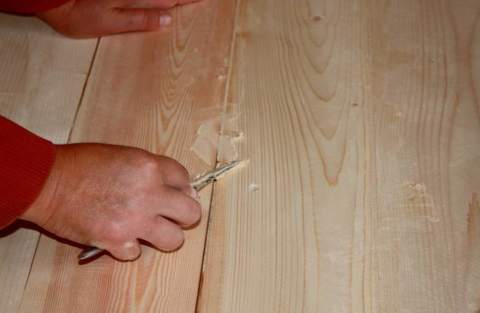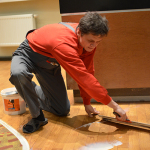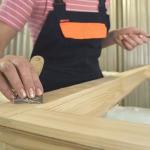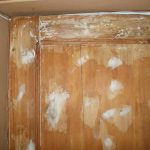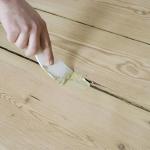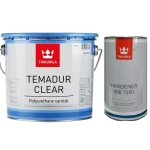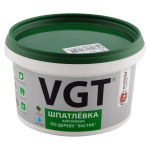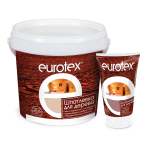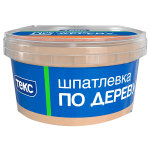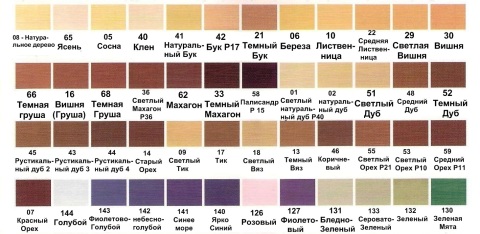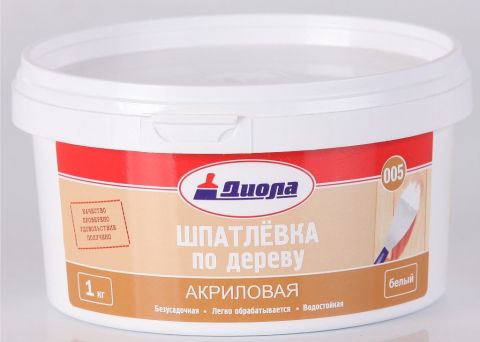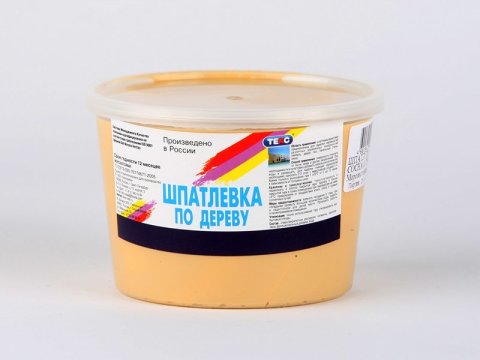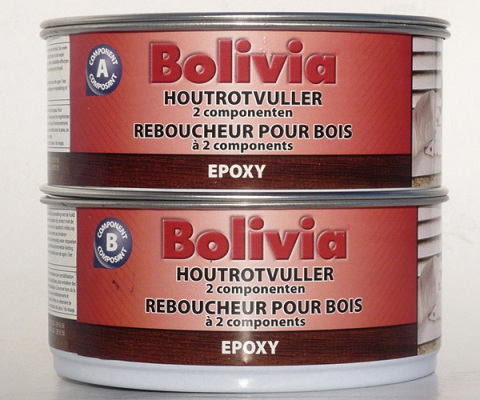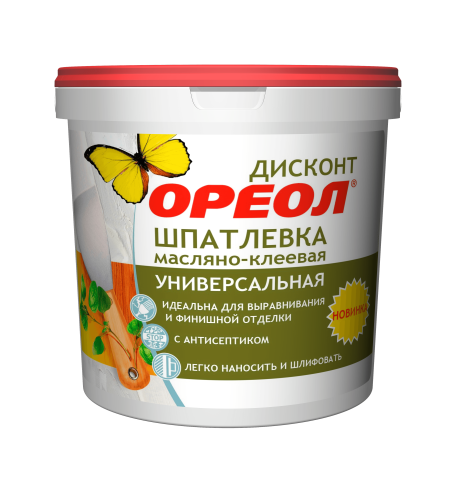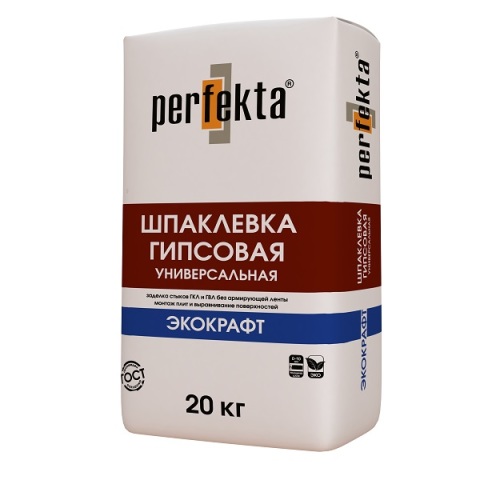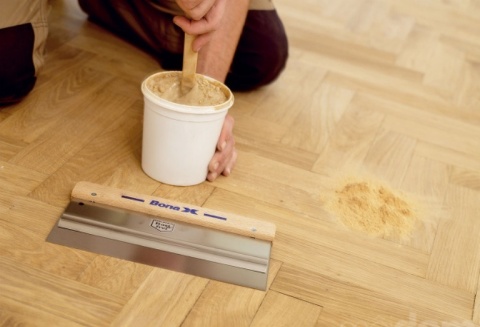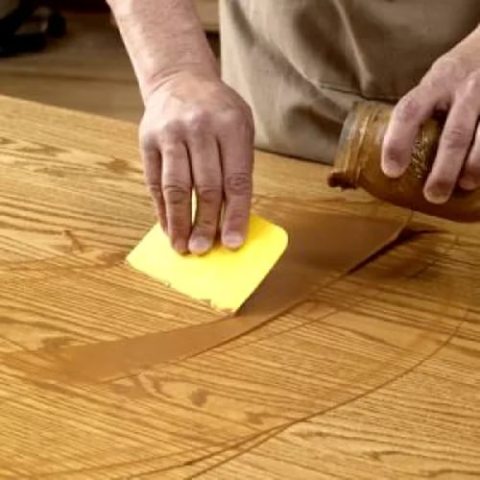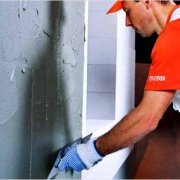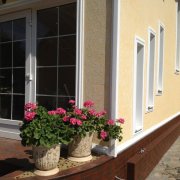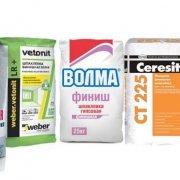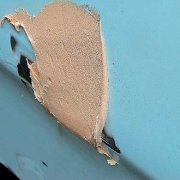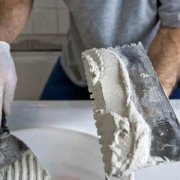Hard putty for wood - we buy or cook ourselves
Many years ago, humanity made one very useful discovery - people learned how to use gypsum, preparing from it mixtures, which we today call putty. This material is actively used in decoration and repair of various surfaces.
Wood processing was not an exception, for which many compositions with special properties were invented, which will be discussed in this article. We will also tell you how to putty putty for wood with your own hands.
The content of the article
What gives a putty on wood
As already mentioned, the range of putties is very large, which makes it very difficult to navigate when buying. Therefore, let's analyze in which cases we need putty, and also determine the areas of its application and the optimal composition, since for each specific case it may differ.
Scope of application
Putty for wood is used in the processing or restoration of various surfaces. It is used in the decorative decoration of MDF paneling (seeMDF paneling: do it right) or plywood, in preparation for painting new parquet floors, as well as in the restoration of door leafs, window frames and repair of old wood flooring. And these are just the most common applications.
- Floor treatment before painting
- Window frame restoration
- Hard putty for wood for doors - blade repair
- Repair old flooring
Let's list the properties that a surface treated with putty on wood acquires:
- Putty gives wood moisture resistance, which has a beneficial effect on the service life of the coating;
- All types of compositions perfectly hide various defects and cracks. Moreover, some of them are suitable for fairly large damage to the structures of frames and doors;
- Wood putty emphasizes the natural texture of wood, as some mixtures have a transparent structure;
- The surface treated with such compounds is perfect for painting, or applying a transparent or decorative varnish layer;
- Putty on wood for the floor has an excellent adhesion to the surface, and easily fills all the bumps and cracks that form during operation.
Advice! In order for the putty to last longer, thoroughly clean the surface from dirt, dust and oil stains before applying it to the floor, then be sure to treat the wood with a primer.
Manufacturers
On the shelves of stores it is easy to find mixtures of any varieties and manufacturers, of which there are many today.
The market includes brands produced by both domestic and foreign companies, among which are the following:
- Finnish putty "Tikkurila"
- Putty "VGT"
- Filling "Eurotex"
- Filling on a tree "Tex"
- Tikkurula - Finnish company engaged in the production of mixtures and paints. The price of putty from this manufacturer is often higher than that of direct competitors, but it is worth remembering that the cost is justified by quality. These mixtures are able to imitate the color of wood, have excellent adhesion to the surface, and are suitable for any operating conditions, even with high humidity.
- Lacra - The putty of this company has established itself as an inexpensive and very high-quality option that is suitable for any type of flooring.
- "VGT" - Mixtures of this manufacturer are excellent for painting, have a uniform structure and a good selection of colors.
- Eurotex - inexpensive formulations with good quality.
- Tex - The leader of the domestic market, which offers almost the cheapest mixes. But do not think that the quality of this product is lower than that of competitors - this is not at all the case.
The range of mixtures given above is not complete, and when you come to the store, you will see many other compounds. But how not to get confused when choosing? To do this, read the next chapter, in which we will pay attention to this particular issue.
Choose a mixture in the store or cook at home
All wood processing compounds are divided into two types: water-based and solvent-based. In the store you will most likely be offered the first option, since the second one has high toxicity and is used in industrial production. But if you approach the problem correctly and apply the necessary safety measures, then you can use a mixture of solvent and home.
These mixtures have several advantages over aqueous options:
- a very large selection of natural colors and shades;
- resistance to sudden changes in temperature;
- high adhesion and quick drying.
Since the choice of shades is also very rich in aqueous formulations, let's call this advantage conditional (see photo below).
And now let's take a closer look at the features of each type of putty.
Acrylic putty
It is used to cover smooth decorative surfaces and floors. It has high elasticity, which makes it easy to fill all small cracks. Convenient and practical in work. If you need a ductile ductile material, then choose this option.
To additional advantages acrylic putty let’s take its versatility - in addition to wood, it goes well with other materials. For example: suitable for sealing joints of ceramic tiles, chipboard sheets, OSB boards, plywood and linoleum. Acrylic mixtures are not afraid of fire, have a short drying time and are resistant to moisture.
The disadvantage of this option is the thickness of the applied layer. It should not exceed 2-3 mm, otherwise the putty begins to crack. This does not allow it to be used when closing large cracks and potholes, but if you apply the composition in stages with intermediate drying, then, in principle, you can do it.
Polymer putty
One of these formulations are latex mixtures.
They also have many advantages, namely:
- Polymer putties do not have a pungent odor, which is convenient when working in residential premises;
- Drying time is not much inferior to acrylic analogues;
- These compounds perfectly level the surface;
- They are environmentally friendly materials, and do not have toxicity.
This tool is suitable for processing both natural wood (floor, doors, parquet, etc.), and laminated surfaces (if the desired shade is available). In principle, it has no drawbacks, except for the cost.
Epoxy Putty
Here is a tool, the main purpose of which is the repair of wooden surfaces. It is used for the overhaul of wooden doors, window frames, columns and other structures. It is impervious to moisture and has a very high strength after hardening.
Epoxy putty, like other analogues of this type, has two active components that are mixed with each other, immediately before application. After this, a chemical reaction occurs, resulting in a quick-hardening mass.Detailed instructions on the bank, will indicate the exact time of development and solidification of the composition.
After drying, an incredibly strong surface is formed, which lends itself to grinding and painting. It does not have an unpleasant odor, and does not shrink during drying. The resulting surface is resistant to both aqueous and chemical solvents.
You can not apply stains on epoxy putty, which can be attributed to the lack of this composition. The thing is that the treated places are not burned, forming “bald spots”.
Oil-based putties
Oil, chalk and varnish are added to the composition of these mixtures. Some brands also have PVA glue (seeOil-glue putty: what is it and what is it used for), which increases the strength of this material. In general, durability is the main feature of these putties. But this is not all - they are easy to grind and are immune to moisture, which is why they are great for outdoor work (windows, fences, facades, etc.).
Advice! If there are no antiseptic additives in the putty you have purchased, this treatment should be performed before applying the mixture. This is important for wood operating in high humidity conditions.
Gypsum compounds
Despite the fact that gypsum universal mixtures are afraid of moisture, and the strength and elasticity of the resulting surface is much inferior to modified analogues, many still use them. Such a folk love is justified, since materials from gypsum perfectly let steam through, which contributes to the creation of a natural microclimate in the room. But the main plus is the low cost, thanks to which you can process a large area without having to pat your wallet.
We prepare the putty for the tree ourselves
Imagine that you built a beautiful country house made of wood. And you have plans to plant a plot around it with gardens and alleys of beautiful unfading flowers. But before you begin to ennoble the site, you need to finish the finish. And here the question is about puttying.
What to do when when processing such areas you need to spend a lot of the mixture, and its price hits the budget already exhausted by the construction? In this case, our advice is to cook it yourself, while spending a minimum of money and effort.
The simplest recipe includes only two components: crushed chalk and PVA glue. Pour glue into the container, and with constant stirring, add chalk to it in small portions. Putty will be ready as soon as it starts to resemble thick sour cream in its consistency.
So:
- If the surface to be treated has large cracks, chips and bumps, then add a few more fine sawdust or wood dust to the composition - they will give the putty extra strength. The total drying time of this mixture is 24 hours.
- The following recipe, as the main binder for chalk, has a water-soluble varnish. For these purposes, absolutely any, the cheapest option is suitable.
- Mix both elements until a thick elastic mass is obtained. If you made a little mistake and the mixture came out too thick, add a little water to get the desired result.
- Similarly with the PVA recipe, when processing large cracks, add to the composition of sawdust.
Advice! In order for the sawdust to accumulate moisture, prepare the mixture a day before the intended work.
And finally, the most difficult, but at the same time, the best recipe for the preparation of putty "Extra" class:
- Flaxseed oil - 280 gr.;
- Turpentine oil - 60 gr.;
- Pumice or perlite powder - 30 g .;
- Casein - 20 gr.;
- Gelatin - 20 gr.;
- Ammonia solution (18%) - 20 gr.;
- Water - 300 gr.
For cooking, mix pumice or perlite with oils.After, add water and mix thoroughly. Next, add all remaining ingredients, and re-stir.
The resulting mixture is heated in a water bath with continuous stirring, until a uniform consistency is formed. Then remove the putty from the fire, and leave to cool. Once the composition has cooled to room temperature, you can begin to putty.
This article can be considered completed. In addition, we will only say that if you need putty on wood for outdoor use, then choose solvent-based formulations. If you are interested in the process of preparing putty at home, be sure to watch the video in this article.
